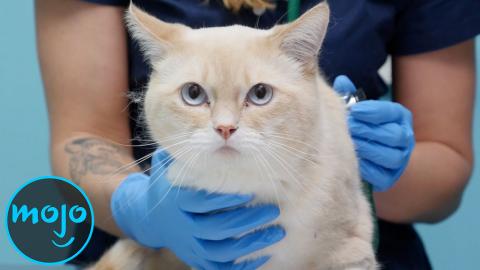Top 5 Things You Should Know Animal Testing

Even with the surge in awareness about animal rights, this practice is still common. From the effects, to the consequences and the research, these facts are need to know. WatchMojo counts down the Top 5 Things You Should Know Animal Testing.
Special thanks to our users tandee82 and Isaac Martinez Chavez for suggesting this idea! Check out the voting page at WatchMojo.comsuggest/top+5+facts+about+animal+testing.
Top 5 Things You Should Know Animal Testing
Top 10 Creepiest Animal Behaviors Caught on Camera
Even with the surge in awareness about animal rights, this practice is still common. Welcome to WatchMojo, and today we’re counting down the Top 5 Things You Should Know About Animal Testing. For this list, we’ll be looking at some of the most disturbing realities about the treatment of animals, specifically within the health and beauty industry.
#5: As Many as 100 Million Animals Are Affected Each Year
While the tides may be changing in some parts of the world, animal testing is still rampant worldwide, even in North America. According to the USDA, anywhere between 12 and 27 million animals are involved in animal testing at any given time in the United States alone. According to PETA however, that number exceeds 100 million. And while the vast majority of these subjects are mice and rats, those aren’t the only species. In addition to small household animals like guinea pigs, hamsters and rabbits, there are also dogs, cats and chimpanzees involved. In the US alone, the USDA has reported that 60 thousand dogs and 20 thousand cats were used for testing in 2015.
#4 It Arguably Isn’t Very Effective
Top 10 Things That Have Gone Viral During the Pandemic
For the most part, testing done on animals does not directly translate to the production of a safe and effective product for humans. It shouldn’t come as a surprise that mice and humans aren’t exactly built the same way. Scientists have long found that cancer treatments in mice didn’t translate to humans, leading some in the field to discredit animal-based cancer research across the board. The same is true for AIDS vaccines- drugs that are effective in preventing the simian equivalent of HIV have failed whe used in human trials.
#3: It Is Banned in Many Other Markets
Top 10 Everyday Things That Are Banned in Russia
As of 2013, the European Union has initiated a complete ban on animal testing in the cosmetics industry. Not only does this ban affect products made and tested on EU soil, it also prevents the sale of any product or ingredient that was tested on animals in other countries. In terms of cosmetic testing, the United Kingdom led the charge on banning tests on animals in 1998 and other countries like India and New Zealand have followed suit in recent years. In China however, any imported cosmetic product must be tested on animals meaning that brands who are cruelty free in other countries are forced to abandon that status if they sell in China.
#2: The NIH Spends a Ton on Animal Research
Top 10 Tips on How to Survive Wild Animal Attacks
The mandate of the US National Institutes of Health (or NIH) is to provide biomedical and public health research for the country. Founded in 1887, this government agency has an annual budget of over $30 billion. The NIH provides research grants in a variety of different medical fields, but their reports show that nearly half of the projects they fund have a component of animal testing involved. Advocates have estimated that this means approximately $10-14 billion goes towards testing on animals every year. Thankfully, as of 2018, there are talks within the NIH about shifting towards more ethical, non-animal methods, at least in terms of toxicity tests.
#1: The USDA Endorses It
Top 30 Strange and Creepy Things Found Frozen in Ice
The United States Department of Agriculture is responsible for the legality of animal welfare in the country, though their primary responsibilities involve laws concerning farming, agriculture, forestry, and food. Because their mandate is so broad, animal rights can often be left by the wayside. The USDA’s Animal Welfare Act of 1966 is the only major law which protects animals in the United States. The AWA provides stipulations for animals involved in research testing, but the law excludes mice, rats, and birds, which are the creatures who make up 95% of all animals tested on in the country. The law also does not prevent specific types of experiment, no matter how painful or deadly.






